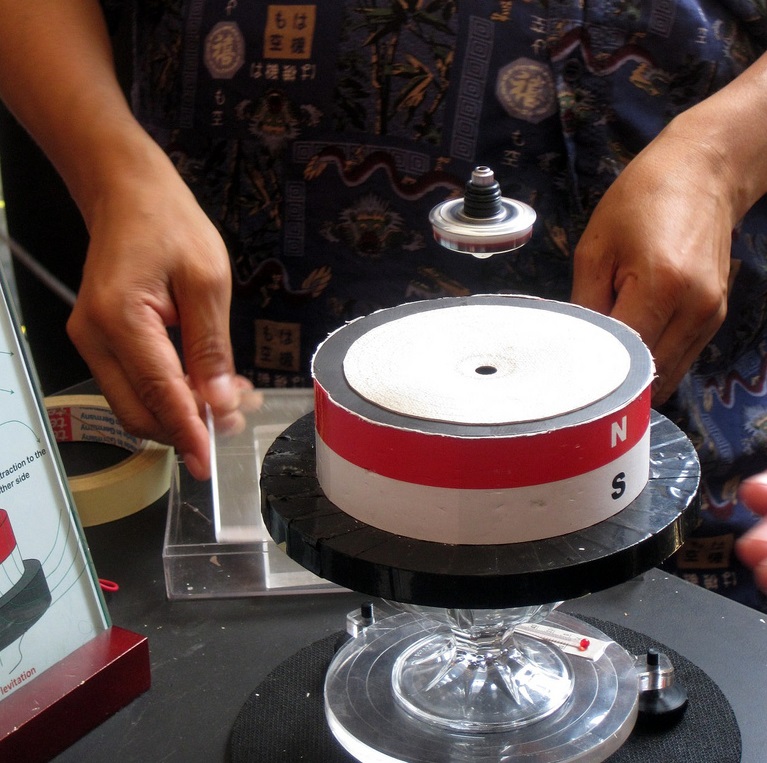|
Goodness Factor
The goodness factor is a metric developed by Eric Laithwaite to determine the 'goodness' of an electric motor. Using it he was able to develop efficient magnetic levitation induction motors. :G = \frac = \frac where : is the goodness factor (factors above 1 are likely to be efficient) :, are the cross sections of the magnetic and electric circuit :, are the lengths of the magnetic and electric circuits : is the permeability of the core : is the angular frequency the motor is driven at : is the conductivity of the conductor From this he showed that the most efficient motors are likely to be relatively large. However, the equation only directly relates to non-permanent magnet motors. Laithwaite showed that for a simple induction motor this gave: :G \propto \frac where is the pole pitch arc length, is the surface resistivity of the rotor Rotor may refer to: Science and technology Engineering *Rotor (electric), the non-stationary part of an alternator or electric mo ... [...More Info...] [...Related Items...] OR: [Wikipedia] [Google] [Baidu] |
Eric Laithwaite
Eric Roberts Laithwaite (14 June 1921 – 27 November 1997) was a British electrical engineer, known as the "Father of Maglev" for his development of the linear induction motor and maglev rail system. Biography Eric Roberts Laithwaite was born in Atherton, Lancashire, on 14 June 1921, raised in the Fylde, Lancashire and educated at Kirkham Grammar School. He joined the Royal Air Force in 1941. Through his service in World War II, he rose to the rank of Flying Officer, becoming a test engineer for autopilot technology at the Royal Aircraft Establishment in Farnborough. On demobilization in 1946, he attended the University of Manchester to study electrical engineering. His work on the Manchester Mark I computer earned him his master's degree. His subsequent doctoral work started his interest in linear induction motors. He derived an equation for " goodness" which parametrically describes the efficiency of a motor in general terms, and showed that it tended to imply that ... [...More Info...] [...Related Items...] OR: [Wikipedia] [Google] [Baidu] |
Electric Motor
An electric motor is an Electric machine, electrical machine that converts electrical energy into mechanical energy. Most electric motors operate through the interaction between the motor's magnetic field and electric current in a Electromagnetic coil, wire winding to generate force in the form of torque applied on the motor's shaft. An electric generator is mechanically identical to an electric motor, but operates with a reversed flow of power, converting mechanical energy into electrical energy. Electric motors can be powered by direct current (DC) sources, such as from batteries, or rectifiers, or by alternating current (AC) sources, such as a power grid, Inverter (electrical), inverters or electrical generators. Electric motors may be classified by considerations such as power source type, construction, application and type of motion output. They can be powered by AC or DC, be Brushed motor, brushed or Brushless motor, brushless, single-phase, Two-phase electric power, two-p ... [...More Info...] [...Related Items...] OR: [Wikipedia] [Google] [Baidu] |
Electronics And Power
The field of electronics is a branch of physics and electrical engineering that deals with the emission, behaviour and effects of electrons using electronic devices. Electronics uses active devices to control electron flow by amplification and rectification, which distinguishes it from classical electrical engineering, which only uses passive effects such as resistance, capacitance and inductance to control electric current flow. Electronics has hugely influenced the development of modern society. The central driving force behind the entire electronics industry is the semiconductor industry sector, which has annual sales of over $481 billion as of 2018. The largest industry sector is e-commerce, which generated over $29 trillion in 2017. History and development Electronics has hugely influenced the development of modern society. The identification of the electron in 1897, along with the subsequent invention of the vacuum tube which could amplify and rectify small elect ... [...More Info...] [...Related Items...] OR: [Wikipedia] [Google] [Baidu] |
Proceedings Of The International Electric Machines And Drives Conference
In academia and librarianship, conference proceedings is a collection of academic papers published in the context of an academic conference or workshop. Conference proceedings typically contain the contributions made by researchers at the conference. They are the written record of the work that is presented to fellow researchers. In many fields, they are published as supplements to academic journals; in some, they are considered the main dissemination route; in others they may be considered grey literature. They are usually distributed in printed or electronic volumes, either before the conference opens or after it has closed. A less common, broader meaning of proceedings are the acts and happenings of an academic field, a learned society. For example, the title of the ''Acta Crystallographica'' journals is New Latin for "Proceedings in Crystallography"; the ''Proceedings of the National Academy of Sciences of the United States of America'' is the main journal of that academy. Sc ... [...More Info...] [...Related Items...] OR: [Wikipedia] [Google] [Baidu] |
Magnetic Levitation
Magnetic levitation (maglev) or magnetic suspension is a method by which an object is suspended with no support other than magnetic fields. Magnetic force is used to counteract the effects of the gravitational force and any other forces. The two primary issues involved in magnetic levitation are ''lifting forces'': providing an upward force sufficient to counteract gravity, and ''stability'': ensuring that the system does not spontaneously slide or flip into a configuration where the lift is neutralized. Magnetic levitation is used for maglev trains, contactless melting, magnetic bearings and for product display purposes. Lift Magnetic materials and systems are able to attract or repel each other with a force dependent on the magnetic field and the area of the magnets. For example, the simplest example of lift would be a simple dipole magnet positioned in the magnetic fields of another dipole magnet, oriented with like poles facing each other, so that the force between mag ... [...More Info...] [...Related Items...] OR: [Wikipedia] [Google] [Baidu] |
Induction Motor
An induction motor or asynchronous motor is an AC electric motor in which the electric current in the rotor needed to produce torque is obtained by electromagnetic induction from the magnetic field of the stator winding. An induction motor can therefore be made without electrical connections to the rotor. An induction motor's rotor can be either wound type or squirrel-cage type. Three-phase squirrel-cage induction motors are widely used as industrial drives because they are self-starting, reliable and economical. Single-phase induction motors are used extensively for smaller loads, such as household appliances like fans. Although traditionally used in fixed-speed service, induction motors are increasingly being used with variable-frequency drives (VFD) in variable-speed service. VFDs offer especially important energy savings opportunities for existing and prospective induction motors in variable-torque centrifugal fan, pump and compressor load applications. Squirrel ... [...More Info...] [...Related Items...] OR: [Wikipedia] [Google] [Baidu] |
Cross Section (geometry)
In geometry and science, a cross section is the non-empty intersection of a solid body in three-dimensional space with a plane, or the analog in higher-dimensional spaces. Cutting an object into slices creates many parallel cross-sections. The boundary of a cross-section in three-dimensional space that is parallel to two of the axes, that is, parallel to the plane determined by these axes, is sometimes referred to as a contour line; for example, if a plane cuts through mountains of a raised-relief map parallel to the ground, the result is a contour line in two-dimensional space showing points on the surface of the mountains of equal elevation. In technical drawing a cross-section, being a projection of an object onto a plane that intersects it, is a common tool used to depict the internal arrangement of a 3-dimensional object in two dimensions. It is traditionally crosshatched with the style of crosshatching often indicating the types of materials being used. With computed ... [...More Info...] [...Related Items...] OR: [Wikipedia] [Google] [Baidu] |
Permeability (electromagnetism)
In electromagnetism, permeability is the measure of magnetization that a material obtains in response to an applied magnetic field. Permeability is typically represented by the (italicized) Greek letter ''μ''. The term was coined by William Thomson, 1st Baron Kelvin in 1872, and used alongside permittivity by Oliver Heaviside in 1885. The reciprocal of permeability is magnetic reluctivity. In SI units, permeability is measured in henries per meter (H/m), or equivalently in newtons per ampere squared (N/A2). The permeability constant ''μ''0, also known as the magnetic constant or the permeability of free space, is the proportionality between magnetic induction and magnetizing force when forming a magnetic field in a classical vacuum. A closely related property of materials is magnetic susceptibility, which is a dimensionless proportionality factor that indicates the degree of magnetization of a material in response to an applied magnetic field. Explanation In the mac ... [...More Info...] [...Related Items...] OR: [Wikipedia] [Google] [Baidu] |
Angular Frequency
In physics, angular frequency "''ω''" (also referred to by the terms angular speed, circular frequency, orbital frequency, radian frequency, and pulsatance) is a scalar measure of rotation rate. It refers to the angular displacement per unit time (for example, in rotation) or the rate of change of the phase of a sinusoidal waveform (for example, in oscillations and waves), or as the rate of change of the argument of the sine function. Angular frequency (or angular speed) is the magnitude of the pseudovector quantity angular velocity.(UP1) One turn is equal to 2''π'' radians, hence \omega = \frac = , where: *''ω'' is the angular frequency (unit: radians per second), *''T'' is the period (unit: seconds), *''f'' is the ordinary frequency (unit: hertz) (sometimes ''ν''). Units In SI units, angular frequency is normally presented in radians per second, even when it does not express a rotational value. The unit hertz (Hz) is dimensionally equivalent, but by convention it ... [...More Info...] [...Related Items...] OR: [Wikipedia] [Google] [Baidu] |
Electrical Conductivity
Electrical resistivity (also called specific electrical resistance or volume resistivity) is a fundamental property of a material that measures how strongly it resists electric current. A low resistivity indicates a material that readily allows electric current. Resistivity is commonly represented by the Greek letter (rho). The SI unit of electrical resistivity is the ohm-meter (Ω⋅m). For example, if a solid cube of material has sheet contacts on two opposite faces, and the resistance between these contacts is , then the resistivity of the material is . Electrical conductivity or specific conductance is the reciprocal of electrical resistivity. It represents a material's ability to conduct electric current. It is commonly signified by the Greek letter ( sigma), but ( kappa) (especially in electrical engineering) and ( gamma) are sometimes used. The SI unit of electrical conductivity is siemens per metre (S/m). Resistivity and conductivity are inte ... [...More Info...] [...Related Items...] OR: [Wikipedia] [Google] [Baidu] |
Arc Length
ARC may refer to: Business * Aircraft Radio Corporation, a major avionics manufacturer from the 1920s to the '50s * Airlines Reporting Corporation, an airline-owned company that provides ticket distribution, reporting, and settlement services * Airport Regions Conference, a European organization of major airports * Amalgamated Roadstone Corporation, a British stone quarrying company * American Record Company (1904–1908, re-activated 1979), one of two United States record labels by this name * American Record Corporation (1929–1938), a United States record label also known as American Record Company * ARC (American Recording Company) (1978-present), a vanity label for Earth, Wind & Fire * ARC Document Solutions, a company based in California, formerly American Reprographics Company * Amey Roadstone Construction, a former British construction company * Aqaba Railway Corporation, a freight railway in Jordan * ARC/Architectural Resources Cambridge, Inc., Cambridge, Massachusett ... [...More Info...] [...Related Items...] OR: [Wikipedia] [Google] [Baidu] |
Resistivity
Electrical resistivity (also called specific electrical resistance or volume resistivity) is a fundamental property of a material that measures how strongly it resists electric current. A low resistivity indicates a material that readily allows electric current. Resistivity is commonly represented by the Greek letter (rho). The SI unit of electrical resistivity is the ohm-meter (Ω⋅m). For example, if a solid cube of material has sheet contacts on two opposite faces, and the resistance between these contacts is , then the resistivity of the material is . Electrical conductivity or specific conductance is the reciprocal of electrical resistivity. It represents a material's ability to conduct electric current. It is commonly signified by the Greek letter ( sigma), but (kappa) (especially in electrical engineering) and (gamma) are sometimes used. The SI unit of electrical conductivity is siemens per metre (S/m). Resistivity and conductivity are intensi ... [...More Info...] [...Related Items...] OR: [Wikipedia] [Google] [Baidu] |








